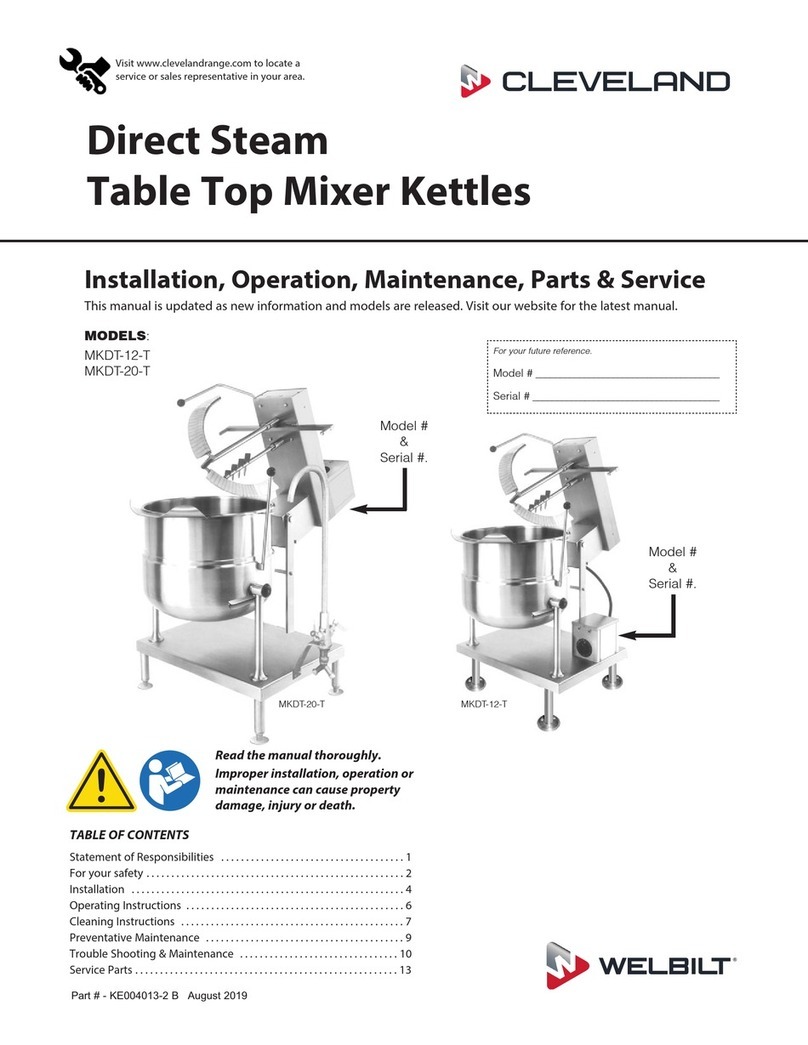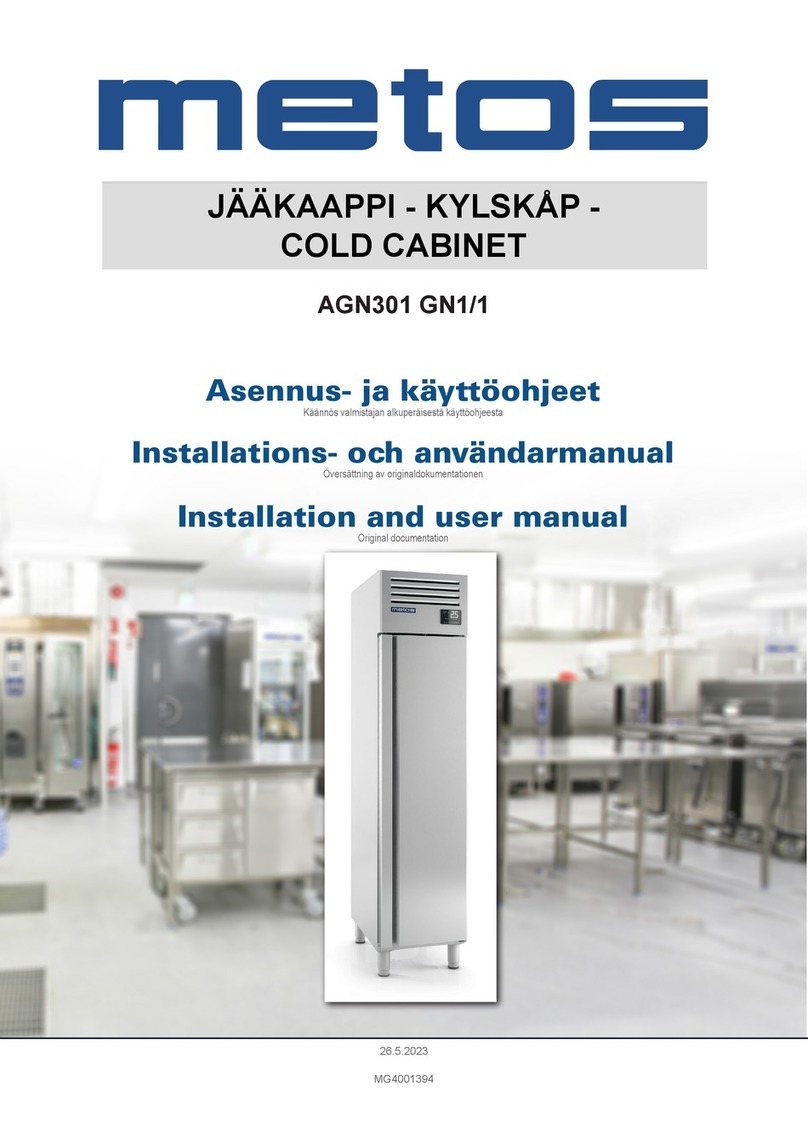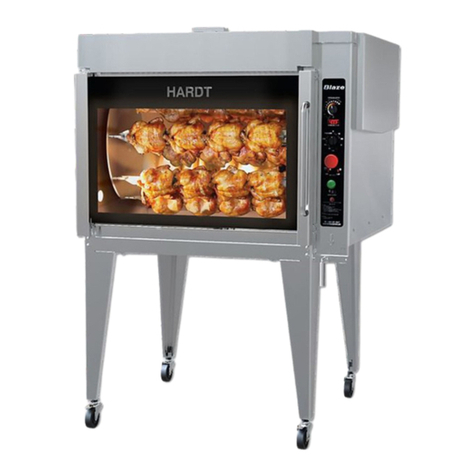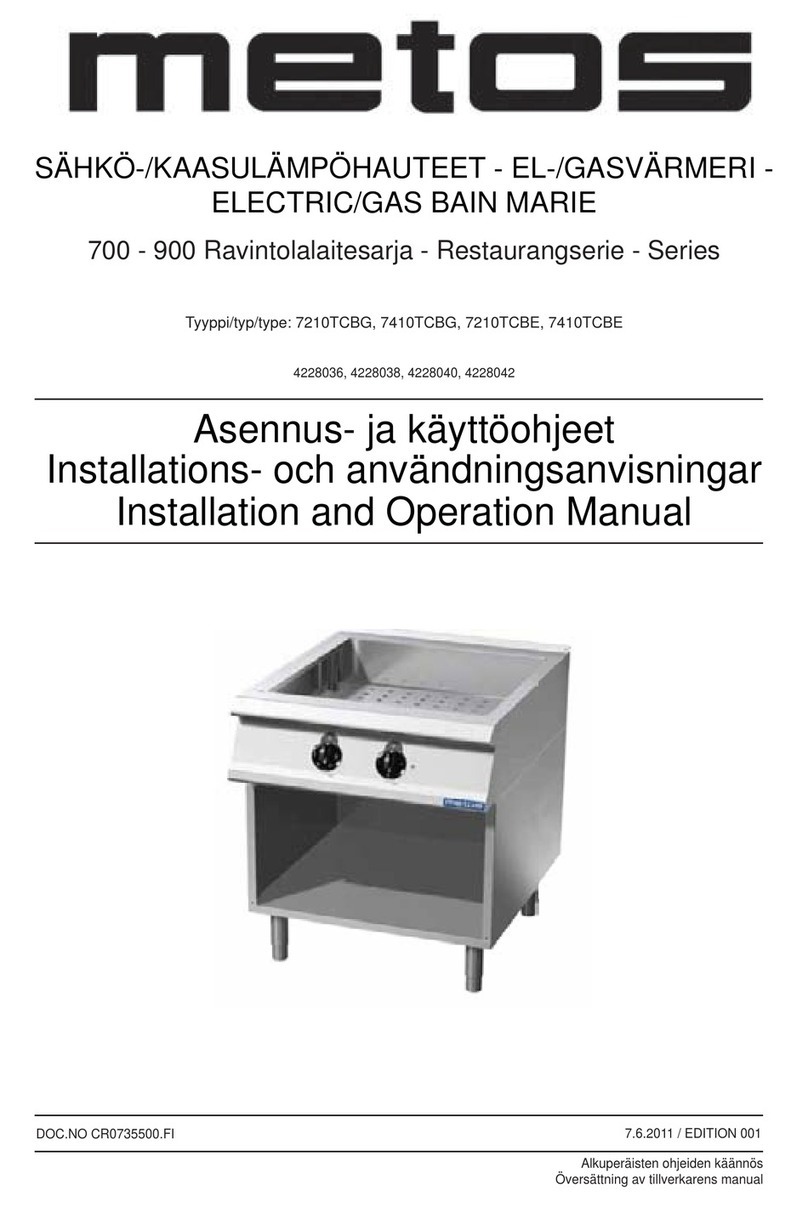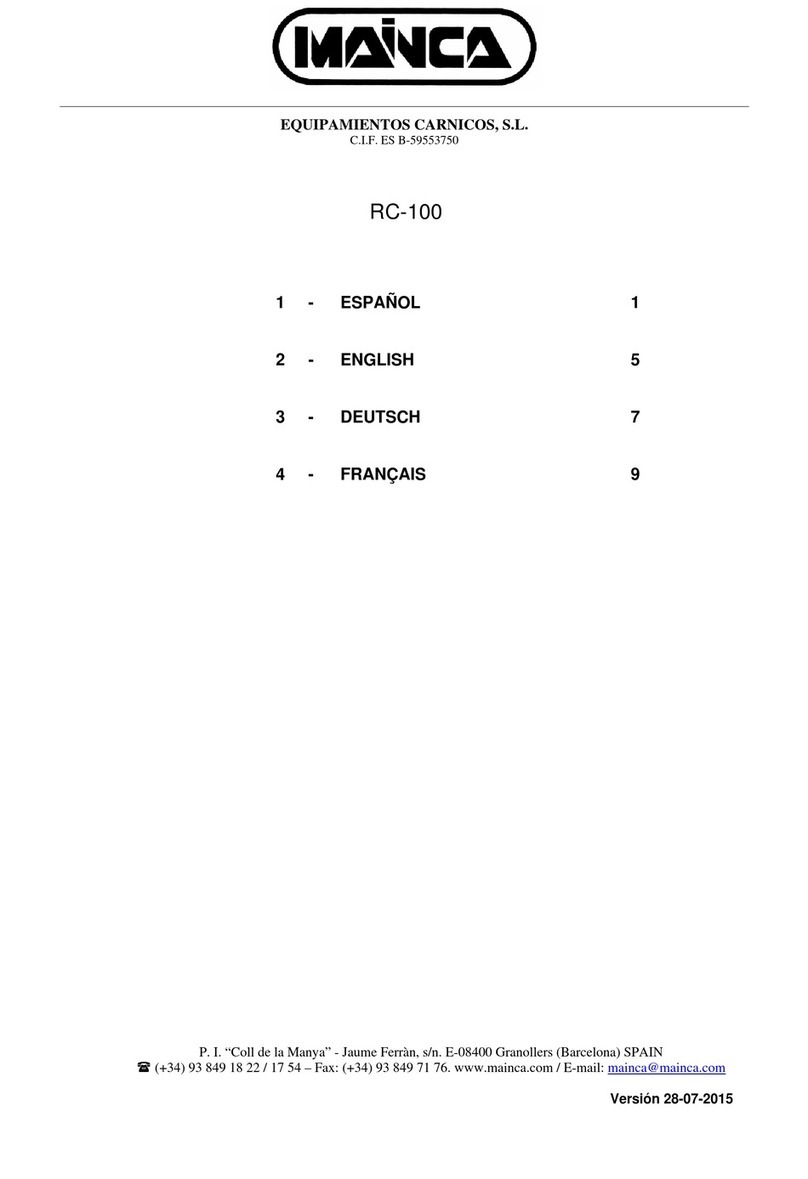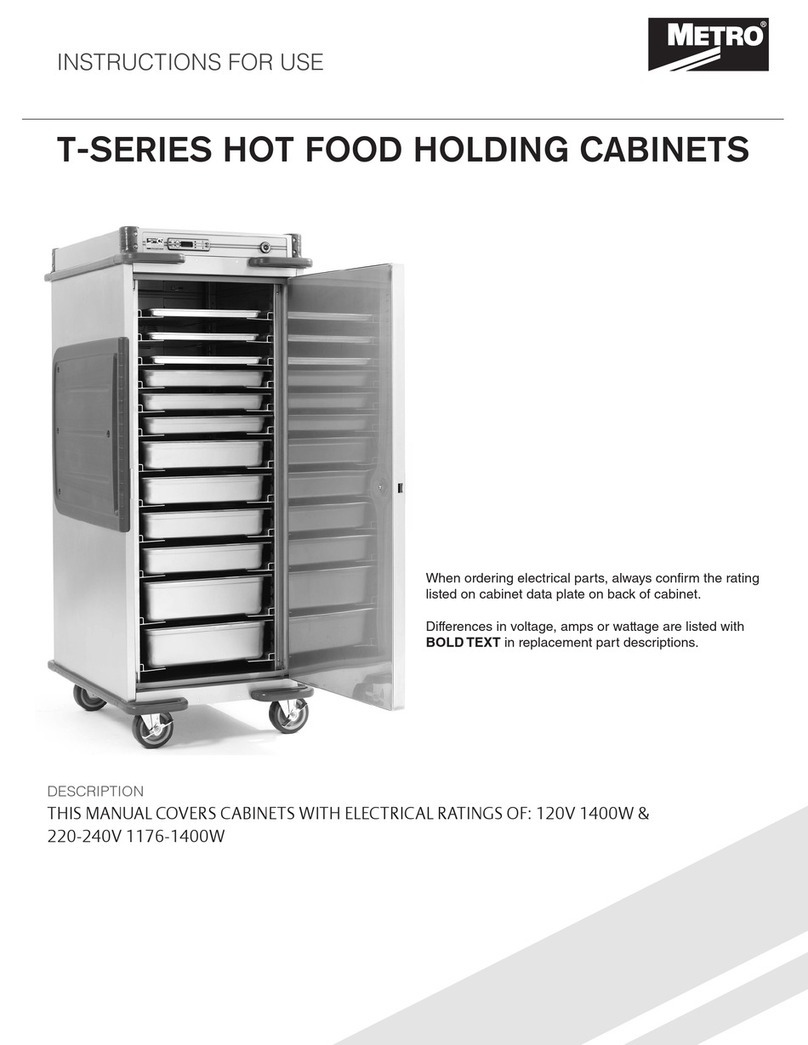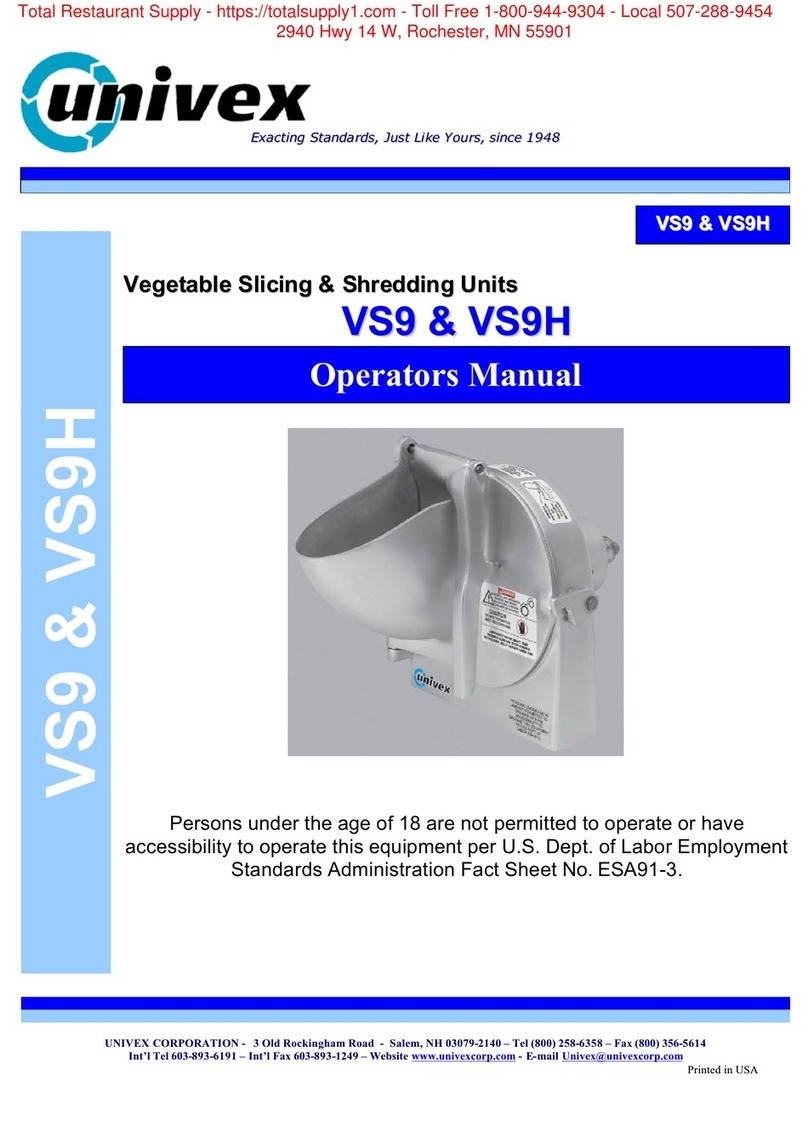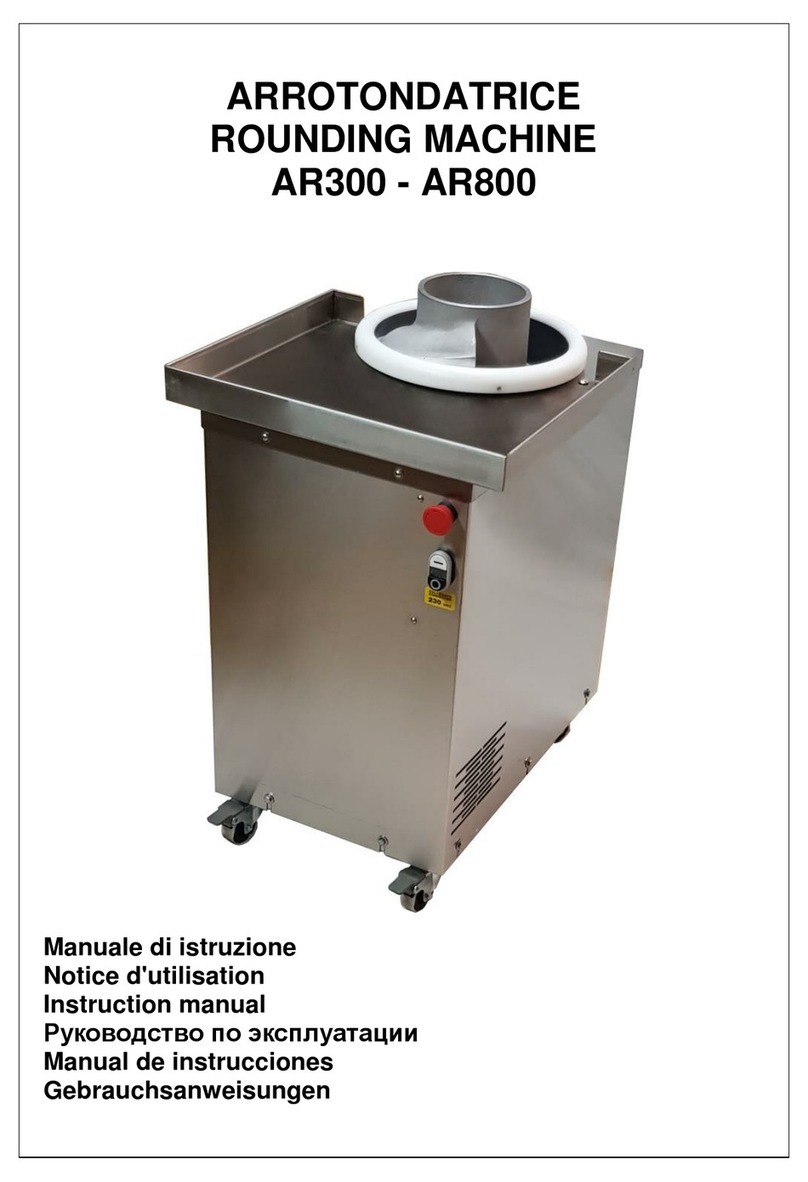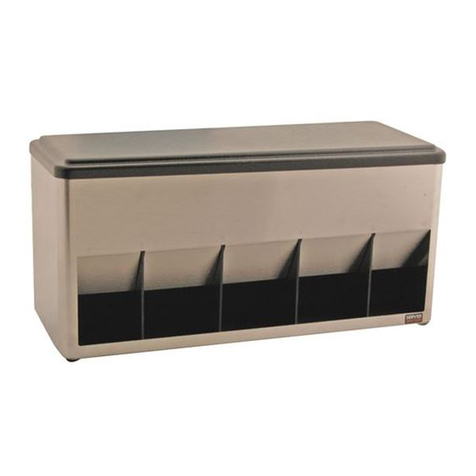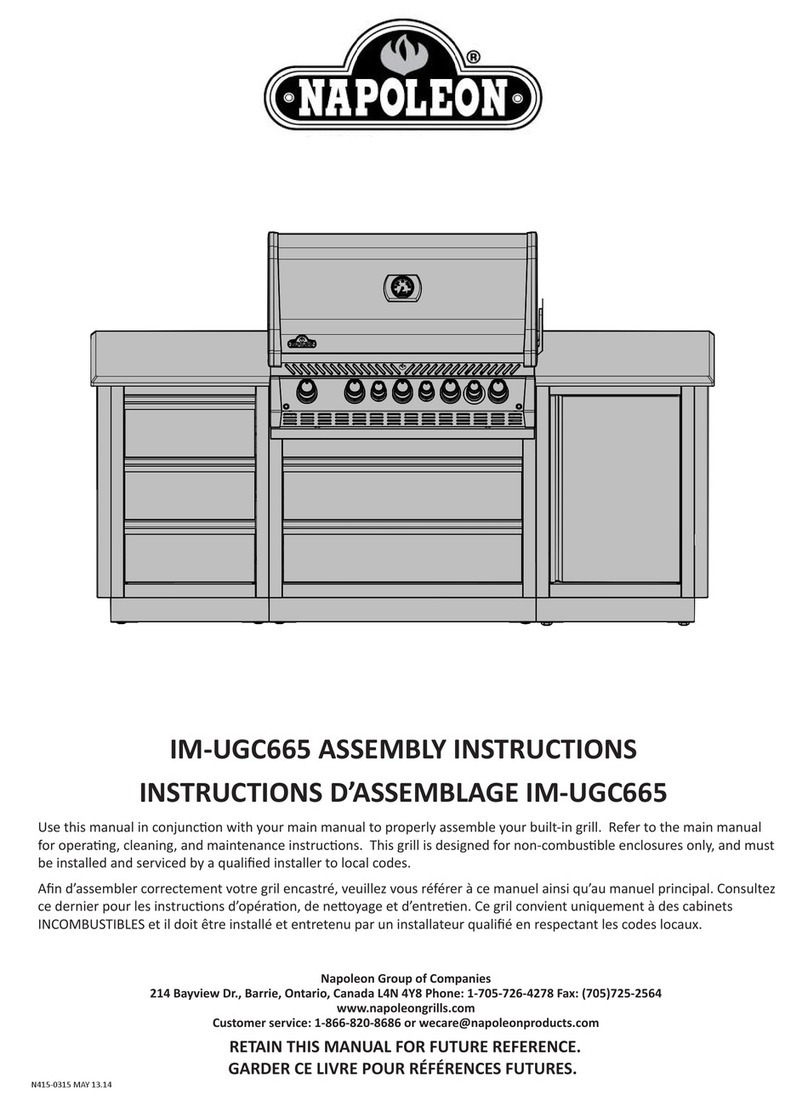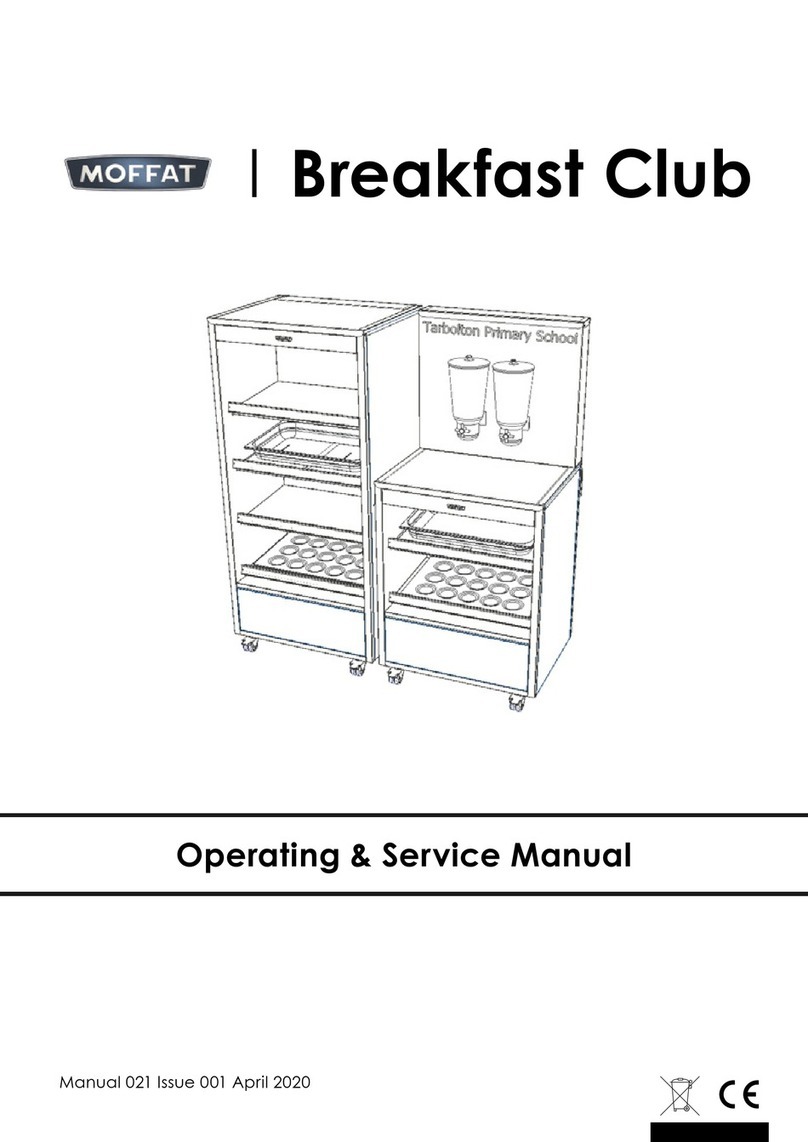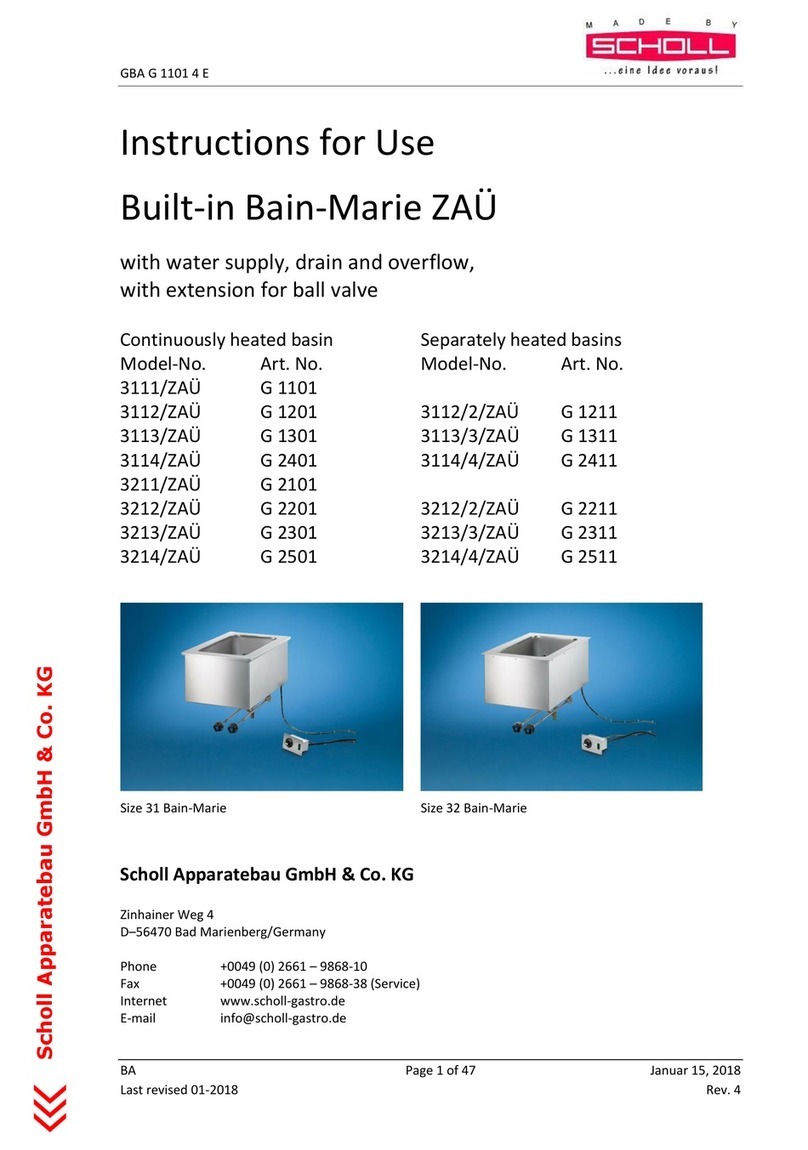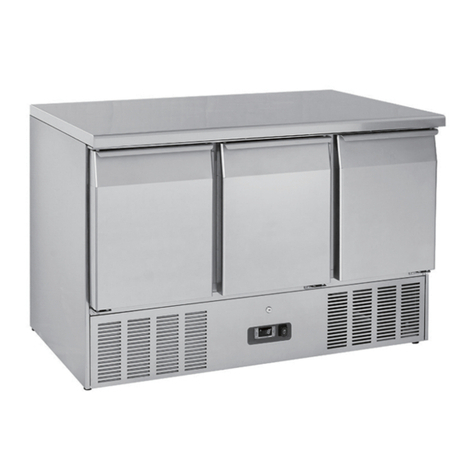Bongard MAJOR Parts list manual

Façonneuse
Moulder
Langwirkmaschine
MAJOR
MAJOR ALPHA
Réf. : 21000292 rev. 02
Version : 16-12-2002
UTILISATION & ENTRETIEN
USE & MAINTENANCE
BEDIENUNGSANLEITUNG

1

2
Vous venez de faire l’acquisition
d’une façonneuse MAJOR et nous
vous remercions de la confiance que
vous portez à notre marque.
Des composants sélectionnés et des
techniques à la pointe du progrès
nous ont permis d’élaborer et de
réaliser cette façonneuse avec le plus
grand soin, notre souci premier étant
l’amélioration constante de la qualité
pour vous assurer le maximum de
satisfactions. Placée dans les
conditions requises, elle répondra à
toutes ses possibilités.
Le spécialiste qui a installé et réglé
votre façonneuse vous en a expliqué
les différents réglages et
commandes.
Nous désirons cependant vous
rappeler dans ce fascicule d’emploi
tout ce qui a été dit pour guider
l’utilisation et l’entretien de votre
façonneuse afin d’en obtenir son
plein rendement, dans les meilleures
conditions.
Pour tous contacts avec le
constructeur, veuillez rappeler les
références portées sur la première
page de la présente notice ainsi que
le numéro du type relevé directement
sur la plaque constructeur (voir aussi
page 4).
You have acquired a Major Moulder,
and we wish to thank you for
choosing our product.
Carefully selected components and
advanced technology are the basis of
this Moulder. We strive to constantly
improve the quality of our products
in order to ensure your complete
satisfaction. If operated under the
specified conditions, the moulder
will perform at its best.
The specialist who has installed and
adjusted your machine will explain
its setting positions and operation to
you.
Nevertheless, you will find this small
manual useful as a reminder of the
rules to observe in the machine’s use
and maintenance in order to keep it
in optimal working condition.
For future contacts with the
manufacturer, please provide
information given on the cover page
as well as the serial number indicated
on the descriptive plate found on the
side of your moulder (see page 4).
Alle Mitarbeiter unseres Hauses
wünschen Ihnen viel Freude und
Erfolg mit Ihrer neuen Maschine.
Mit der Wahl für unsere neue
Konzeption haben Sie sich klar für
den Fortschritt entschieden.
Auf hohem technischen Niveau sind
bei unseren Maschinen Leistung,
Umweltfreundlichkeit und
Wirtschaflichkeit aufeinander
abgestimmt.
Die Bedienung der Super Major ist
zwar denkbar einfach, trotzdem
möchten wir Sie bitten, diese
Bedienungsanleitung durchzulesen,
da sie einige wichtige Hinweise
enthält, die die Arbeit an der neuen
Super Major erleichtert.
Schließlich wollen wir, daß Sie von
Anfang an mit Ihrer neuen Super
Major ungetrübte Freude haben.
Für späteren Kontakt mit dem
Hersteller, genaue Angaben der
Vorderseite dieser Anleitung sowie
des auf der Maschine befestigten
Typenschildes angeben (siehe auch
Seite 4).
¦¦¦¦¦¦¦¦¦¦¦¦¦¦¦¦¦¦¦¦¦¦¦¦¦¦¦¦

3
SOMMAIRE
Pages
Anomalies de
Fonctionnement 21
Autres caractéristiques 12
Calendrier d’entretien 20
Caractéristiques électri-
Ques 6
Entretien 19
Fiche technique 9-11
Généralités 7-8
Installation 5
Limites d’utilisation
Plaque d’identification 4
Liste des pièces de
Rechange 27-30
Mise en service 13
Notes 39
Réglages 14-15
Remplacement de
Pièces 22-26
Schémas électriques 16-18
Vues éclatées 31-38
CONTENTS
Pages
Breakdowns and
solutions 21
Data sheet 9-11
Dismantling, Replacing
Parts 22-26
Electrical 6
Exploded views 31-38
General Characteristics 7-8
Installation 5
Maintenance 19
Maintenance schedule 20
Mise en service 13
Notes 39
Setting the moulder 14-15
Spare parts list 27-30
Special characteristics 12
Use limits
Identification plate 4
Wiring diagram 16-18
INHALT
Seite
Allgemeines 7-8
Auswechseln der
Ersatzteile 22-26
Besondere Eigenschaften 12
Datenblatt 9-11
Einstellung 14-15
Elektrische Eigenschaften
6
Ersatzteil-
Zeichnungen 31-38
Ersatzteilliste 27-30
Gebrauchsgrenzen
Typenschild 4
Inbetriebnahme 13
Installation 5
Notizen 39
Schaltpläne 16-18
Störungen 21
Wartung 19
Wartungsperioden
(Kalender) 20
ATTENTION !
Avant tout nettoyage ou toute
intervention sur la machine, couper
l’alimentation électrique.
CAUTION !
At all times, before cleaning or for
maintenance of the machine, shut off
the power supply.
VORSICHT !
Vor jeder Reinigung oder vor
jedem Einsatz der Maschine,
Hauptschalter ausschalten;
Netzstecker ziehen.

4
GENERALITES
Limites d’utilisation
Cette machine à usage professionnel
est exclusivement destinée à la mise
en forme de produits comestibles
contenant de la farine, de l’eau et
d’autres additifs (pain, viennoiserie
et pâtisserie).
GENERAL
Limitations to use
This professional-use machine is
exclusively meant for the moulding
of edible products containing flour,
water and other additives (bread,
Vienna pastries and pastries.)
ALLGEMEINES
Gebrauchseignung
Diese Spezial-Maschine ist nur zum
Langwirken von Teigen, die Mehl,
Wasser und andere Additive
enthalten (Brot, Feingebäck, usw...
vorgesehen.
Détail de la plaque
Signalétique
Detail of the descriptive
plate
Typenschild details
1.Logo
2.Adresse du constructeur
3.Type de la machine
4.Numéro de série
5.Année de fabrication
6.Puissance électrique (kW)
7.Tension (V)
8.Intensité (A)
9.Fréquence (Hz)
10.Poids en kg
1. Manufacturer’s logo
2. Name and address of ma
nufacturer
3. Type of machine
4. Sérial number of your machine
5. Year of manufacture
6. Electrical power (kW)
7. Voltage (V)
8. Intensity (A)
9. Frequency (Hz)
10. Weight in kg
1. Logo des Herstellers
2. Name und Adresse des Herstel-
lers
3. Maschinentyp
4. Serien-Nummer
5. Baujahr
6.Elektrische Leistung (kW)
7. Spannung (V)
8. Stromaufnahme (A)
9. Frequenz (Hz)
10. Gewicht in kg
1
4
3
2
8
6
10
7
9
5

5
INSTALLATION
COLISAGE
La façonneuse MAJOR est livrée
boulonnée sur une palette en bois et
recouverte d’un carton cerclé sur la
palette.
Les tapis évacuateurs 1TE à 5TE
sont livrés sur palette dans une caisse
en bois (voir page 12)
INSTALLATION
PACKAGE
The MAJOR Moulder is securely
bolted onto a wooden pallet and is
delivered in a cardboard box. The
conveyor belts (1TE to 5TE) are also
fastened onto a wooden pallet and
delivered in a wooden box.
(see page 12)
INSTALLATION
VERPACKUNG
Die MAJOR wird auf einer
Holzpalette festgeschraubt und mit
einem Karton überzogen
geliefert.Die Auslaufteppiche (1TE
bis 5TE) befinden sich in einer
Holzkiste auf einer Holzpalette.
(siehe Seite 12)
Major Major
Colisage / Packing / Verpackung métropole caisse
maritime
Largeur / Width / Breite (mm) 1030 1110
Profondeur / Length / Tiefe (mm) 870 1060
Hauteur / Height / Höhe (mm) 880 960
Poids / Weight / Gewicht (kg) 172 210
CONDITIONS DE STOCKAGE
-20°C à + 60°C à l’abri de l’humidité
et des attaques d’agents extérieurs.
MANUTENTION
L’utilisation d’un chariot élévateur est
fortement conseillée.
DEBALLAGE
Lors du déballage , il faut prendre
garde de ne pas abîmer le contenu du
colis. Enlever les cales qui tiennent le
caisson arrière.
Attention, pour la mise en place de la
façonneuse, il faut la déboulonner de la
palette.
MONTAGE ET MISE EN PLACE
·Demonter les 2 carters latéraux et utiliser
les entretoises basses comme poignées
pour porter la machine sur une courte
distance (2 personnes)
Remonter ces 2 carters avant mise en
route
·Dans le cas d’un montage de la
façonneuse sur un tapis évacuateur, il
faut la boulonner sur celui-ci.
·Dans le cas d’une configuration MADA,
la façonneuse est simplement posée sur le
plan incliné.
·Dans le cas d’une implantation sur
Repose - Pâton (RP), il y a lieu de monter
la cale pour incliner la machine.
ATTENTION !
Vérifier qu’il n’y a pas de corps étranger
(boulon, cale en bois, outil...) dans la
machine avant sa mise en route.
STORAGE CONDITIONS
Store in a cool, dry place (-20°C to
+ 60°C).
HANDLING
The use of a fork-lift is strongly
advised.
UNPACKING
During unpacking, be careful not
to damage the contents. Remove the
wooden blocks that support the rear
case during shipment. Remember to
unbolt the moulder from the pallet
before putting it place.
ASSEMBLY AND MOUNTING
·Remove the 2 side casings and hold the
distance pieces as they were handles, in
order to put the machine on the work
place (2 persons). Assemble the 2
casings before starting the machine.
·When mounted on top of the conveyor
belt, it is necessary to bolt the moulder
onto it.
·When used with the MADA, the moulder
is simply positioned on the inclined
surface.
·When mounted on top of the resting
cabinet, there is space under the moulder
to fix black, rubber vibration isolators.
ATTENTION !
Verify that there aren’t any foreign objects
(bolts, wooden support blocks, tools...) in
the machine before starting up.
AUFBEWAHREN
In einem kühlen und trockenen Raum (-
20°C bis + 60°C) aufbewahren.
TRANSPORT
Es wird empfohlen, einen Gabelstapler zu
verwenden.
AUSPACKEN
Beim Auspacken, Inhalt der Lade nicht
beschädigen.
Holzkeile, die bewegliche Teile während
des Transportes festhalten, entfernen.
Maschine von ihrer Palette abschrauben.
MONTAGE
·Die zwei Seitengehäuse abmontieren und
die unteren Distanzstücke wie Griffe
anfassen, um die Maschine am
Arbeitsplatz aufzustellen (2 Personen).
Diese 2 Gehäuse wieder montieren, bevor
die Maschine angelassen wird.
·Wenn die Maschine mit einem
Auslaufteppich geliefert wurde, muß
dieser mit der Maschine verschraubt
werden.
·Bei einem MADA-Vorgärs-chrank
wird die Maschine einfach auf die
vorgesehene Schrägfläche gestellt.
·Zur Aufstellung auf einen RP-
Vorgärschrank müssen Gummi-
Unterlagen verwendet werden.
VORSICHT !
Überprüfen, ob sich keine Fremdkörper
(Schrauben, Holzkeile, Werkzeug...) in
der Maschine befinden.

6
CARACTERISTIQUES
ELECTRIQUES
ELECTRICAL
CHARACTERISTICS
ELEKTRISCHE
DATEN
CARACTERISTIQUES ELECTRIQUES / ELECTRICAL CHARACTERISTICS /
ELEKTRISCHE DATEN
Puissance / Power / Leistung (W) 550
Tension-fréquence / Voltage-frequency / Spannung-Frequenz
Câblage standard / Standard cabling / Tri 400 N + T
Standard Verkabelung 400V 3 Ph + N + E 402V Ph + Mp + Erde 50 Hz
Sur demande / Optional / Auf Wunsch Autre tension / Other tension / Andere Spannung 50/60 Hz
l y a deux possibilités de câblage :
·Major MANU (p.16)
·Major ALPHA RTM et MADA
(p.17 et 18)
REGLAGE DE L’INTENSITE DE
DECLENCHEMENT DU MOTO-
PROTECTEUR
En cas de déclenchement fréquent du
moto-protecteur (code21001581, pages
29 et 34), il faut vérifier son réglage
d’intensité de déclenchement.
Pour ce faire, il faut démonter le bouto
n
1 et le cadre carré 2 en
p
renant soin de ne pas abîmer le bloc d
e
commande (voir figure ci-dessous).
A l’aide d’un tournevis, régler l’inten-
sité 3 suivant le tableau suivant:
There are two possible wirings :
·Major MANU (p.16)
·ALPHA RTM and MADA Majors (p.17
& 18)
REGULATING THE TENSION OF
THE MOTOR PROTECTIVE SWITCH
In case of frequent tripping of the motor
protective switch (code 21001581, pages 29
& 34), it is necessary to verify the tension
of the contactor.
To do this, it is necessary to dismantle the
button (1) and the square cover (2) taking
care not todamage the control box (see
figure below).
With the help of a screwdriver, adjust the
tension (3) according to the following table :
Es gibt zwei Anschlussmöglich-keiten :
·Major MANU (Seite p.16).
·Major ALPHA RTM u. MAD
A
(Seiten 17 u.18 ).
EINSTELLUNG DER STROMAUF-
NAHME DES MOTOR SCHUTZ-
SCHALTERS
Sollte der Motorschutzschalter (Ref.
21001581, Seiten 29 u. 34) öffters
ausfallen, mubseine Einstellung
überprüft werden.
Drehknopf 1 Abdeckung 2 sorgfältig
abnehmen (siehe untere Abbildung). Mit
einem Schraubenzieher die genaue
Stromaufnahme (3) laut Tabelle
einstellen :

-7-
CARACTERISTIQUES
GENERALES
La machine est de faibles encombrement
et poids. L’allongement des pains est doux
et progressif entre deux tapis tournant en
sens inverse à des vitesses différentes.
L’introduction des pâtons se fait par
l’avant entre les deux cylindres lamineurs
plastifiés de diamètre différent permettant
ainsi un laminage différentiel.
La réception des pâtons façonnés se fait
également par l’avant sur une planche
rabattable recouverte d’un feutre ou sur un
tapis évacuateur.
Le châssis est composé de deux flasques
en alliage d’aluminium AU4G reliés par
trois entretoises, assurant
l’indéformabilité.
Elle est montée sur pieds à roulettes
pivotantes, mais elle peut être utilisée sans
pied, en la posant sur une table. Elle peut
être également fixée sur un rail de 2 à 6
mètres de long. Voir page 35.
Tous les cylindres d’entraînement ainsi
que toutes les pièces tournantes sont
montés avec des roulements à billes
étanches graissés à vie.
L’entraînement se fait par moteur et
courroie trapézoïdale pour la réduction
primaire, et par courroie dentée pour la
transmission secondaire.
Des carters facilement démontables, par
vis, protègent les différentes parties
tournantes.
Options:
·MAJOR pour intégration sur MADA;
·MAJOR pour intégration sur RTM /
CPB
·MAJOR avec tapis d’alimentation 450
mm;
·Pied avec roulettes;
·Rail de suspension;
·Piétement avec 6 étagères en bois.
GENERAL
CHARACTERISTICS
This machine does not take up
gret volume and is relatively light.
Shapping of loaves is done gently and
gradually between two belts moving in
opposite directions at different speeds.
The introduction of the pieces of dough is
done at the front between two plastified
laminating cylinders with a different
diameter which allows a differential
rolling.
The receiving of shaped pieces of dough
also done at the front on a folding surface
covered with feld or on an outfeed
conveyor belt.
The frame is made up of two AU 4G
aluminium alloy shields connected by
three braces, guaranteed not to warp.
The machine rests on legs with casters. It
can be used without legs if it is placed on a
table. It can also be fixed to a rail 2 to 6
meters long. See page 35.
All delivery rolls as well as all revolving
parts are fixed with permanently greased
safety ball bearings.
Movement is performed by motor and
trapezoidal belts for primary reduction,
and flat notched belt for secondary
transmission.
A casing (easily dismantable by screws)
protects the various turning parts.
Options:
·MAJOR to be buit in with MADA;
·MAJOR to be built in with RTM/CPB
·MAJOR with infeed conveyor belt 450
mm
·Stand on casters;
·Suspension rail;
·Stand fitted with 6 wooden boards.
ALLGEMEINE
BESCHREIBUNG
Die Maschine hat einen geringen
Raumbedarf und ein geringes Gewicht.
Das Langwirken der Brote erfolgt
schonend zwischen zwei Bändern, die
zueinander in entgegengesetzter Richtung
und mit verschiedenen Geschwindigkeiten
laufen.
Die Einführung der Teigstücke erfolgt von
vorn (Bedienungsfront) über einen kurzen
mit Filz belegten Trichterdirekt zwischen
dem Walzenpaar, deren Oberfläche
kunststoffbeschichtet und deren
Durchmesser verschieden groß sind .
Der Auslauf der gewirkten Teigstücke
erfolgt ebenfalls nach vorn auf ein
schwenkbares mit Filz bedecktes
Auslaufblech.
Der Rahmen besteht aus zwei
Seitenwänden (Aluminium-Leigierung),
die durch drei Traversen so verbunden
sind, daß die Formbeständigkeit gesichert
bleibt.
In Normalausführung ist die Maschine auf
ein fahrbares Gestell mit Schwenkrollen
montiert. Die Maschine kann aber auch
ohne Gestell verwendet werden, wenn man
sie auf einen Tisch setzt.
Auch kann sie auf einer Schiene von 2 bis
6 Meter Länge befestigt werden (siehe
Seite 35).
Alle sich drehenden Teile wie
Antriebsteile und Übertragungsteile sind
mit abgedichteten Kugellagern für eine
lange Laufzeit versehen.
Die Primärübersetzung erfolgt über Motor
und Keilriemen. Für den Weitertrieb ist
ein Zahnriemen vorgesehen.
Alle Antriebsteile sowie die elektrischen
Anschlüsse sind zugänglich durch
Abschrauben der beiden seitlichen
Verkleidungsbleche.
Zubehör:
·MAJOR zum Einbau in MADA;
·MAJOR zum Einbau in RTM/CBP
·MAJOR mit Einlauf - Teppich 450 mm;
·Fahrbares Gestell;
·Aufhängeschiene;
·Gestell mit 6 Holzregalen.

-8-
DESCRIPTION
GENERALE
La machine comporte :
·Un tapis avant tournant sur trois
cylindres en triangle à l’intérieur duquel
est logé le moteur.
·Un tapis arrière tournant en sens
inverse sur deux cylindres.
·Deux cylindres de laminage de
diamètre différent, revêtus de plastique,
tournant sur roulements à billes
étanches. Le plus petit cylindre est
mobile sur excentrique et permet le
réglage de l’écrasement de la pâte lors
du laminage.
Les réglages du laminage et de
l’allongement sont progressifs et précis
grâce au système vis et écrous (p.14).
Ils sont situés sur la face avant où 2
compteurs rappellent la position du
laminage et de l’allongement.
·Le châssis est constitué par deux
flasques en alliage d’aluminium
maintenus par trois entretoises nickelées.
·Un moteur monté sur un support
pivotant permet de tendre la courroie
trapézoïdale. Puissance du moteur : 0,55
kW à 1 000 tr/mn, pour courant 50 Hz.
Major MANU :
·L’introduction se fait par une goulotte
inclinée à 1,35 m du sol, équipée d’une
sécurité en fonctionnement manuel.
·La réception sur planche, rabattable,
recouverte de feutre, à 0,85 m du sol en
position de travail ou sur un tapis
évacuateur (TE).
Major Balancelles (RTM, MADA, CBC)
:
La machine est alimentée automati
quement.
GENERAL
DESCRIPTION
Components :
·A front belt spinning on three cylinders
in a triangle inside of which is the motor.
·A back belt spinning in the opposite
direction on two cylinders.
·Two rolling cylinders of différent
diameters, plastic-covered, rolling on
safety ball bearings.
The smaller cylinder moves on a cam
and permits control of the spread of the
dough during rolling.
Control of rolling and of shaping is
gradual and precise thanks to the system
of screws and bolts (p.14)
Located on the front face are two control
Knobs, with respective meters, that
indicate the position of rolling and
shaping.
·The frame is made up of two light alloy
anti-corrosive shields kept in place by
three nickelplated braces.
·A motor mounted on a pivotal support
plate allowing the tightening of the
trapezoidal belt. Power of the motor :
0,55 kW to 1000 rpm, for 50 Hz current.
MANU «Major » :
·Entry is through an inclined chute 1,35 m
from the ground, équipped with a
manually controlled safety system.
·Reception on a felt-covered folding
surface 0,85 m from the ground in
working position or on an outfeed
conveyor.
« Major » used with intermediate
proofers (RTM, MADA, CBC) :
The machine is fed automatically.
BESCHREIBUNG
DER MASCHINE
Die Arbeitselemente und die Einstell-
elemente der Maschine bestehen aus :
·einem vorderen Filzband, das über
drei Walzen im Dreieck läuft, in dessen
Hohlraum der Motor untergebracht ist.
·einem hinteren Filzband, das über zwei
Walzen, mit seiner Arbeitsfläche in
Richtung von unten nach oben läuft.
·einem Walzenpaar, dessen Zylinder
verschiedene Durchmesser besitzen,
deren Oberfläche mit Kunststoff
beschichtet ist.
Die kleinere Walze ist in Exzentern
beweglich und einstellbar gelagert, um
den Walzenspalt in seiner Größe dem
Teig anzupassen. Die Einstellung des
Walzenspaltes für das Pressen beim
Auswalzen des Teiges erfolgt durch
Drehen am oberen Handgriff. Die
genaue Einstellung wird am
Anzeigewerk im Handgriff abgelesen
(siehe Seite 14). Mit dem unteren
Handgriff wird die Länge des Wirklings
festgelegt.
·Der Antriebsmotor ist auf eine
schwenkbare Stütze montiert. Nach dem
Lösen von zwei Schrauben und dem
Schwenken der Motorstütze nach unten
kann der Keilriemen nachge- spannt
werden. Die Stärke des Motors beträgt
0,55 kW bei 1000 Umdrehungen/Minute
für einen Strom von 50 Hz.
Major MANU :
·Die Einführung der Teiglinge erfolgt in
einen Trichter, dessen vordere Kante eine
Höhe von ca.1,35 M Abstand vom Boden
besitzt.
·Das schwenkbare mit Filz überzogene
Auslaufblech hat in Arbeitsstellung eine
Höhe von etwa 0,85 Metern Abstand
vom Erdboden.
Die Ablage der Teiglinge kann auch auf
einem Auslaufteppich (TE) erfolgen.
Major mit Vorgärschrank (RTM,
MADA, CBC) :
Automatischer Einlauf des Teiges.

-9-
Major
Manu / Standard
Fiche technique / Data sheet / Datenblatt
UTILISATION / USE / BETRIEB
Poids des pâtons / Weight of dough pieces / Gewicht der Teigstücke
Mini 80g
Maxi 1000g
Cadence / Rate / Leistung (Pâtons de 330g. avant cuisson / loaves of 330g
before baking / Teigstücke 330 Gr. vor dem Backen)
1500
pièces/hour - Teile/Stunde
Production horaire / Production per hour / Stunde -Produktion (Pâtons de 550g avant
cuisson / loaves of 550g before baking / Teigstücke 550 Gr. vor dem Backen)
825 Kg
Largeur de tapis / Width of conveyor belty / Teppich-Breite 740 / 750 mm
CARACTERISTIQUES GENERALES / GENERAL CHARACTERISTICS / ALLGEMEINE DATEN
Dimension / Dimension / Maße Sur piétement / With stand / Auf Gestgell
Major Manu Major Standard
Hauteur / Height / Höhe
Major mm 690
Totale / Overall / Gesamt mm 1530
Alimentation / Infeed / Einlauf mm 1350 1446
Sortie / Outlet / Ausgang mm 880
Largeur / Width / Breite mm 1010
Profondeur / Length / Gesamt
Major mm 800
Hors tout / Overall / Gesamt mm 800 850
Fonctionnelle / Useful / Nutzbare.. mm 1700
Surface au sol / Foor space / Bodenfläche m21,72
Poids / Weight : Gewicht (kg) Kg 132 135
DISPOSITIF DE SÉCURITÉ BARRE SENSIBLE CLAPET BASCULANT
MAJOR MANU MAJOR STANDARD
sur pied (en accessoires)
690
1010
850

-10-
Major
Mada / Semi-auto / auto
Fiche technique / Data sheet / Datenblatt
UTILISATION / USE / BETRIEB
Poids des pâtons / Weight of dough pieces / Gewicht der Teigstücke
Mini 80g
Maxi 1000g
Cadence / Rate / Leistung (Pâtons de 330g. avant cuisson / loaves of 330g
before baking / Teigstücke 330 Gr. vor dem Backen)
1500 / 1500 / 1800
pièces/hour - Teile/Stunde
Production horaire / Production per hour / Stunde -Produktion (Pâtons de 550g avant
cuisson / loaves of 550g before baking / Teigstücke 550 Gr. vor dem Backen)
825 Kg
Largeur de tapis / Width of conveyor belty / Teppich-Breite 740 / 750 mm
CARACTERISTIQUES GENERALES / GENERAL CHARACTERISTICS / ALLGEMEINE DATEN
Dimension / Dimension / Maße Sur Mada / With Mada /
Auf Mada
Sur TE / With
conveyor gelt / Auf
Teppich
Sur TE / With
conveyor gelt / Auf
Teppich
Major Mada Major semi-auto Major Auto
Hauteur / Height / Höhe
Major mm 690
Totale / Overall / Gesamt mm 1530
Alimentation / Infeed / Einlauf mm 1350 1446 1450
Sortie / Outlet / Ausgang mm 940
Largeur / Width / Breite mm 1010
Profondeur / Length / Gesamt
Major mm 800 1250
Hors tout / Overall / Gesamt mm 850
Fonctionnelle / Useful / Nutzbare.. mm 1700
Surface au sol / Foor space / Bodenfläche m21,72
Poids / Weight : Gewicht (kg) Kg 136 130 150
DISPOSITIF DE SECURITE BARRE SENSIBLE PROTECTION TUNNEL
140
690
1250
1010
MAJOR AUTO
avec kit séchage feutre (en option) MAJOR AUTO sur 2TE . avec kit séchage
feutre (en option)

-11-
Major
Manu / Mada / auto
Fiche technique / Data sheet / Datenblatt
UTILISATION / USE / BETRIEB
Poids des pâtons / Weight of dough pieces / Gewicht der Teigstücke
Mini 80g
Maxi 1000g
Cadence / Rate / Leistung (Pâtons de 330g. avant cuisson / loaves of 330g
before baking / Teigstücke 330 Gr. vor dem Backen)
1500 / 1500 / 2000
pièces/hour - Teile/Stunde
Production horaire / Production per hour / Stunde -Produktion (Pâtons de 550g avant
cuisson / loaves of 550g before baking / Teigstücke 550 Gr. vor dem Backen)
825 Kg
Largeur de tapis / Width of conveyor belty / Teppich-Breite 740 / 750 mm
CARACTERISTIQUES GENERALES / GENERAL CHARACTERISTICS / ALLGEMEINE DATEN
Dimension / Dimension / Maße Sur piétement / With
stand / Auf gestgell
Sur Mada / With Mada
/ Auf Mada
Sur TE / With conveyor
gelt / Auf Teppich
Major Manu Major Mada Major Auto
Hauteur / Height / Höhe
Major Alpha mm 690
Totale / Overall / Gesamt mm 1530
Alimentation / Infeed / Einlauf mm 1220 1280
Sortie / Outlet / Ausgang mm 880 940
Largeur / Width / Breite mm 1010
Profondeur / Length / Gesamt
Major Alpha mm
Hors tout / Overall / Gesamt mm 850
Fonctionnelle / Useful / Nutzbare.. mm 1700
Surface au sol / Foor space / Bodenfläche m21,72
Poids / Weight : Gewicht (kg) Kg 142 146 140
DISPOSITIF DE SECURITE BARRE SENSIBLE
MAJOR ALPHA MANU
sur piétement tubulaire (en accessoires)
MAJOR ALPHA AUTO
sur 2TE
690
1010
1530
880
1220
850
630

-12-
CARACTERISTIQUES DES CONVOYEURS EVACUATEURS DE PATON FAÇONNES TE
FEATURES OF THE "TE" DOUGH EXIT BELTS
MERKMALE DER TEIGENTLEERUNGSBÄNDER MOD. TE
TYPE 1TE 2TE 3TE 4TE 5TE
Code article/item number/artikel-nr. 29900012 29900022 29900032 29900152 29900132
Puissance/Power/Leistung kw 0,09 0,09 0,09 0,09 0,09
Dimensions et poids/dimensions and weights/abmessungen un gewicht
Longueur x largeur/Lenght x width/Länge x Breite mm 1150x930 1850x930 2450x930 3250x930 4000x930
Hauteur/Height /Höhe mm 880 880 880 880 880
Largeur x longueur utile/Useful width/Nutzbare Breite mm 690x530 690x1240 690x1950 690x2660 690x3370
Poids net/Net weight/ Netto-Gewicth mm 85 110 140 160 180
EMBALLAGE / PACKING / VERPACKUNG
METROPOLE/domestic/Inland 1TE 2TE 3TE 4TE 5TE
L/W/L mm 1560 1860 2600 3400 4000
I/D/B mm 950 950 950 950 950
H mm 590 590 590 590 590
KG 142 175 200 250 300
MARITIME (CAISSE) L/W/L mm 1560 1860 2600 3400 4000
Seaworthy (case) I/D/B mm 950 950 950 950 950
Seemässig (Kiste) H mm 590 590 590 590 590
KG 142 175 200 250 300
AUTRES CARACTERISTIQUES
TECHNIQUES
Nature des matériaux :
·Tapis de façonnage: 100% pure
laine.
·Tapis lourd : PVC.
·Feutre sous tapis lourd : laine
aiguilletée.
·Cylindres lamineurs: âme acier
recouvert de PVC.
·Racleurs : PVC.
·Goulotte de sortie : revêtement
laine aiguilletée.
·Option tapis d’alimentation : coton.
Répartition de la charge au sol :
Façonneuse MAJOR sur pied =
250 kg/m2
Niveau sonore :
Mesures du bruit effectuées suivant
les normes ISO/DIS 11201 &
PR EN 312.
Mesures effectuées en champ libre sur
surface réfléchissante et sur l’appareil à
vide.
Distance de mesure : 1 m.
Hauteur de mesure : 1,60 m.
Niveau de bruit (Laeq) = 58 dBA
SPECIAL CHARACTERISTICS
Matérial :
·Conveyor belt: 100% pure wool.
·Heavy belt: PVC.
·Felt under heavy belt: spécial wool.
·Rolling cylinder : steel core covered
by PVC.
·Scrapers : PVC.
·Exit chute: special wool covering.
·Optional conveyoor belt : made of
cotton.
Distribution of the load on floor :
MAJOR moulder on stand = 250
kg/m2.
Sound level:
Noise measurements are according to
the norms ISO/DIS 11201 &
PR EN 312.
Measurements are carried out in an
open area on a reflecting surface when
the machine is empty.
Measuring distance : 1 m.
Measuring height : 1,60
Noise level (Laeq) = 58 dBA
ZUSÄTZLICHE TECHNISCHE
DATEN
Materialen :
·Teppich: 100% wolle.
·Schweres Band : PVC.
·Filz unter dem schweren Band:
Spezialwolle.
·Langwirkrollen : Stahl-Kern mit PVC
überzogen.
·Abstreifer: PVC
·Ausgabetrichter : mit Spezial-Wolle
überzogen.
·Auf Wunsch: Einfahrteppich :
Baumwolle.
Gewichtverteilung :
MAJOR auf Füße = 250 kg/m2.
Geräuschpegel:
Nach ISO/DIS 11201 &
Pr EN 312.
Meßabstand : 1m.
Meßhöhe : 1,60 m.
Geräuschpegel (Laeq) = 58 dBA
¦¦¦¦¦¦¦¦¦¦¦¦¦¦¦¦¦¦¦¦¦¦¦¦¦¦¦¦

-13-
MISE EN SERVICE DE LA
MACHINE :
Avant la première mise en route de la
machine, s’assurer que votre installation
soit conforme à nos spécifications.
Sans précisions de la part du client, toutes
nos machines sont branchées en 400 V.
Pour changer de tension sur une Major
standard:
Changement de câblage au niveau du
motoprotecteur suivant le schéma page 16.
Régler l’intensité de déclenchement du
motoprotecteur suivant la tension choisie
(voir page 6).
Avant la première mise sous tension,
s’assurer que le moteur tourne dans le bon
sens. Pour ce faire:
1Dégager le tapis lourd du dessus et le
faire reposer sur la goulotte d’entrée.
2Faire tourner la machine un très court
instant (environ 1 seconde), et contrôler
que le tapis « triangle » tourne vers le
haut de la machine.
3 Si ce n’est pas le cas, inverser deux fils
à l’alimentation de votre façonneuse.
4.Vérifier avant l’utilisation en
production le bon fonctionnement de la
barre se sécurité, en appuyant dessus la
machine doit s’arrêter par déclenchement
du motoprotecteur. Cette opération de
vérification de la sécurité doit être
effectuée chaque jour. En cas de
dysfonctionnement, ne travailler jamais
sans sécurité, appeler de suite votre
dépanneur.
INTO PUTTING THE
MACHINE SERVICE :
Before starting up the machine for the first,
make sure your installation complies with
our specifications.
If the customer does not specify otherwise,
all our machines use 400 V current.
In order to change the voltage for the
standard Major:
Refer to page 16 for chamging the wiring
of the motor protective switch.
Refer to p.6 to regulate the tension of the
contactor of the motor protective switch
according to the voltage chosen.
Before switching on the power supply,
make sure that the motor is spinning in the
correct direction.
To do this:
1Release the heavy belt and let it rest on
the entry chute.
2 Turn on the machine very briefly
(about 1 second), then turn it off. Make
sure that the circular belt spins upward
toward the top of the machine.
3In case the circular belt spins
backwards, reverse two input wires.
4-Before using the machine, make sure
the safety bar works well. Pushing it, the
machine stops thanks to the motor
protector disconnection. Do this safety
control operation every day. In case of
malfunction, do not work without safety
but ask immediately for a technician's
intervention.
INBETRIEBNAHME DER
MASCHINE :
Vor der ersten Inbetriebnahme der Maschine sollte
man sich vergewissern, ob die Maschine unseren
Anforderungen hinsichtlich der Stromversorgung
entspricht.
Auber auf besonderen Wunsch des Kunden
werden unsere Maschinen für den Anschluban
400 Volt Drehstrom geliefert.
Zum Spannungswechsel das linke
Verkleidungsteil abnehmen und entsprechend des
Schaltplans anschlieben Abb. Seite 16.
Intensität des Motorschutzschalters entsprechend
umändern (siehe Seite 6).
Vor der ersten Inbetriebnahme überprüfen ob der
Motor in die richtige Richtung dreht.
Um dies zu tun:
1 Das obere schwere Förderband abnehmen.
2 Kurz den Kontakt herstellen, ohne den Schalter
festzuhalten. Das Förderband muß sich nach oben
bewegen.
3 Sollte sich der Motor in die falsche Richtung
drehen, zwei Anschlußkabel vertauschen
4-Bevor die Maschine benützt wird, den
einwandfreien Betrieb der Sicherheitsstange
überprüfen. Wenn die Stange gedrückt wird, muss
die Maschine dank dem Ausschalten des
Motorschutzes anhalten. Diese Überprüfung der
Sicherheitsvorrichtung muss täglich ausgeführt
werden. Im Störungsfall nicht ohne
Sicherheitsvorrichtung arbeiten, sondern sofort
einen Kundendiensttechniker rufen

-14-
REGLAGES
Remarque :
Avant utilisation, vérifier que :
·Laminage fermé : la poignée
indique zéro.
·Allongement fermé au maximum:
la poignée indique zéro.
Si ce n’est pas le cas, il faut
étalonner chaque poignée à mettant
àzéro le computer intérieur, à l’aide
soit d’un tournevis soit d’une clé
mâle, procéder comme l’indiquent
les figures 1 et 2”.
SETTINGS
Remarks :
before using the machine, verify
that :
·when the rolling cylinder is in its
minimum position, the knob
indicates zero.
·when the lengthening cylinder is in
its minimum position, the knob
indicates zéro.
If necessary, calibrate each handle
resetting the inside computer with a
screw driver or a male wrench,
operating as indicated by fig. 1 and
2.
EINSTELLUNG
Bemerkung :
Vor dem Gebrauch überprüfen:
·Walzen total zu. Handgriff auf 0.
·Länge-Einstellung total zu.
Handgriff auf 0.
·Falls nötig, jeden Griff kalibrieren,
indem der Computer innen mit Hilfe
eines Schraubenziehers oder eines
Steckschlüssels nullgestellt wird, wie
auf den Abb. 1 und 2 gezeigt.
PRODUITS REGLAGE LAMINAGE REGLAGE ALLONGEMENT
PRODUCTS SETTINGS FOR ROLLING SETTINGS FOR SHAPING
PRODUKTE WALZEN VERLÄNGERN
Baguette crue / Unbaked baguette /
Baguette ungebacken 350 g. 2 H 00 10 H 00
Pain long cru / unbaked long loaf of bread /
langes Brot ungebacken 530 g. 4 H 00 9 H 00
Pain court cru / unbaked short loaf of bread
kurzes Brot vor dem Backen 530 g, 4 H 00 6 H 00
Ficelle crue /unbaked french bread stick/
Brot 150 g. 1H 50 10 H 30
Les réglages sont donnés en heures
et minutes
(ex. = 2 H 30).
Remarque :
Les indications de réglage données
ci-dessus ne sont qu’indicatives et nécessitent
des essais en fonction des conditions
de panification et des caractéristiques
des ingrédients.
The setting are given in hours and
minutes
(ex. = 2 H 30).
Remark:
The settings given above are only
indications and require trials according to
the bread-making process and ingredient
characteristics
Die Einstellwerte werden in Stunden
und Minuten angegeben
(z.B. = 2 H 30)
Bemerkung:
Die angegebenen Werte sind
Richtwerte und sollen je nach Rezept
und gewünschtem Ergebnis
ausprobiert werden.
1.Réglage laminage
Adjusting the rolling cylinder
Einstellung des Walzenspaltes
2.Réglage allongement
Adjusting the lenght
Einstellung der länge

-15-
REGLAGE DE LA
FACONNEUSE
Recommandations :
1Peser le plus possible de pâtons à
l’avance.
2Fleurer le plus possible de pâtons sur
le tour.
3Bien fariner le feutre de réception
4 Prendre les pains par le milieu à la
sortie, en les soulevant.
5Si le pain est trop serré, ouvrir le
cylindre lamineur.
6Si le pain n’est pas assez serré,
resserrer le cylindre lamineur.
7Si le pain est trop court, refermer
l’ouverture du caisson AR.
8 Si le pain est trop long, augmenter
l’ouverture du caisson AR.
9Si le pain a le gros ventre, il manque
de serrage au laminage, ou la pâte a
trop de force.
10 Si les bouts vrillent, le caisson est
trop serré.
11 Pour tous ces réglages, agir
progressivement en partant du
réglage indicatif ci-après (page 14).
Ce réglage pouvant varier selon la
force des pâtes et le travail effectué
(sur levain, direct, « poolish » ou
méthode pain blanc).
DANS L’ENSEMBLE, IL EST
RECOMMANDE DE NE PAS
TRAVAILLER LA PATE AVEC
TROP DE FORCE ET DE PESER
LE PLUS POSSIBLE DE PATONS
A L’AVANCE.
N’effectuer les réglages que lorsque la
machine tourne; veiller à la propreté de
la façonneuse en ouvrant la protection
arrière, la goulotte d’entrée, et en
démontant périodiquement les carters
droit et gauche pour un entretien
approfondi.
SETTING THE MOULDER
Recommendations :
1Weigh as many dough portions ahead of
time as possible.
2Lightly flour as many dough portions as
possible on the lathe.
3Thoroughly flour the receiving felt.
4Take loaves out by the middle at the
delivery end while lifting them.
5If the loaf is too compact,open the rolling
cylinder.
6If the loaf is not compact enough,tighten
the rolling cylinder.
7If the loaf is too short, close the opening
of rear case.
8If the loaf is too long, further open rear
case.
9If the loaf is puffed up, tightening during
rolling was insufficient , or the dough is
too tough.
10 If the ends curl up, the case is too tight.
11 For all these settings, operate
gradually starting witht those schown
on (page 14).Settings may vary
according to the toughness of the dough
and the type of kneading done (on
leaven, direct, sponge dough or white
bread method).
IN GENERAL, IT IS
RECOMMENDED NOT TO KNEAD
THE DOUGH TOO VIGOROUSLY
AND TO WEIGH AS MANY DOUGH
PORTIONS AS POSSIBLE AHEAD
OF TIME.
These settings should be carried out only
when the machine is running. Make sure
that the moulder ist clean and regularly
remove the right and left guards.
EINSTELLUNG DER
WIRKMASCHINE
Es wird empfohlen :
1Eine größere Menge von Teigstücken
im voraus abzuwiegen.
2Möglichst viele Teiglinge gleichzeitig
Umlauf zu bringen
3 Den Filzbelag auf Auslaufblech gut zu
bemehlen.
4 Die Brote beim Austritt in der Mitte
zu fassen und anzuheben.
5 Wenn das Brot zu stark eingerollt ist
(zu viele Windun-gen), so ist der
Walzenspalt zu vergrößern.
6 Wenn das Brot zu wenig eingerollt
ist (zu wenig Windungen), so ist der
Walzenspalt zu verkleinern.
7Wenn das Brot zu kurz ist, so ist die
Öffnung des Langwirkkanals zu
schließen bzw, enger zu stellen.
8 Wenn das Brot zu lang ist, so ist die
Öffnung das Langwirkkanals weiter
zu stellen.
9Wenn das Brot zu dick ist, so fehlt es
an Spannung beim Walzen oder der Teig
hat
zu viel Kraft.
10 Wenn sich die Enden spiralig
einrollen, so ist der Langwirkkanal zu
eng.
11 Bei allen Einstellungen der
Maschine ist zunächst von der
nachstehend aufgeführten
Grundeinstellung auszugehen (Seite
p.14). Es zeigt sich sofort, ob ein Teig
mehr oder weniger Kraft erfordert und
in welcher Richtung die Maschine neu
einzustellen ist.
Stets soll die weitere Verstellung in
kleinen Abständen, annähernd
stufenlos und mit Gefühl erfolgen. Bei
Teigen mit starkem Roggenanteil,
Sauerteigen oder Weizenteigen nach
der sogenannten grünen Methode muß
zunächst probiert werden.
INSGESAMT WIRD EMPFOHLEN,
DEN TEIG NICHT MIT ZUVIEL
KRAFT ZU BEARBEITEN UND
DIE TEIGLINGE NACH DEM
WIEGEN ETWAS RUHEN ZU
LASSEN.
ACHTUNG:
Maschine nicht im Stillstand regeln!
Alle Einstellungen nur bei laufender
Maschine vornehmen!

-16-
MAJOR
SCHEMA ELECTRIQUE MAJOR ET WIRING DIAGRAM MAJOR AND ELEKTROSCHALTPLAN MAJOR UND
MAJOR ALPHA MANU STANDARD MAJOR ALPHA MANU STANDAR MAJOR ALPHA MANU STANDARD

-17-
MAJOR
SCHEMA ELECTRIQUE MAJOR ET WIRING DIAGRAM MAJOR AND ELEKTROSCHALTPLAN MAJOR UND
MAJOR ALPHA MANU STANDARD MAJOR ALPHA MANU STANDAR MAJOR ALPHA MANU STANDARD

-18-
MAJOR
SCHEMA ELECTRIQUE MAJOR ET WIRING DIAGRAM MAJOR AND ELEKTROSCHALTPLAN MAJOR UND
MAJOR ALPHA MANU STANDARD MAJOR ALPHA MANU STANDAR MAJOR ALPHA MANU STANDARD

-19-
MAJOR
SCHEMA ELECTRIQUE MAJOR ET WIRING DIAGRAM MAJOR AND ELEKTROSCHALTPLAN MAJOR UND
MAJOR ALPHA MANU STANDARD MAJOR ALPHA MANU STANDAR MAJOR ALPHA MANU STANDARD
This manual suits for next models
1
Table of contents
Other Bongard Commercial Food Equipment manuals

